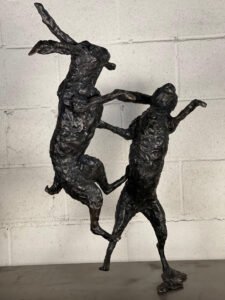

Each bronze sculpture by Charles Elliott begins not with metal, but with imagination. Before a single tool is picked up, the vision for the piece is carefully explored through pencil sketches, drawn by Charles himself. These early sketches mark the first stage of a journey that can take many months, sometimes over a year, to complete. Every sculpture is a product of patience, mastery, and a deep understanding of form, movement, and emotion.
Once the design is finalised, Charles builds a supportive armature from metal rods and wire. This inner skeleton provides strength and structure for the clay to be applied around it. Sculpting clay is then methodically clad around the armature, forming the basic mass and volume of the future sculpture.
Here, the true artistry begins. Charles sculpts entirely by eye, guided only by his hands, intuition, and decades of experience. Using a variety of hand tools, he pushes, smooths, adds, and subtracts clay in a constant state of refinement. The surface is adjusted millimetre by millimetre, week after week, with details emerging gradually as the sculpture begins to take on a life of its own. Nothing is rushed, each angle, muscle, and expression is tweaked to perfection. The clay master may take weeks or even months to complete.
Once Charles is completely satisfied with the clay master, the next phase is to create a mould, a critical process that must preserve every intricate detail. Multiple layers of silicone rubber are applied to the clay surface. These flexible layers pick up even the smallest of textures and tool marks. After the first silicone coat, small cards are used to create a natural split in the mould, allowing it to be opened later. Locators (small indentations and keys) are carefully added between each section so the mould fits back together precisely.
A hard ceramic jacket is then applied over the silicone, giving the mould rigidity and strength for the next phases. Once the mould is cured, the original clay sculpture is carefully removed, leaving behind an exact negative of the piece.
The empty silicone mould is then reassembled, and molten wax is poured inside. This wax version will serve as the final model for casting. Once cooled, the wax sculpture is removed from the mould and refined by hand to match the precision of the original clay master. Any imperfections are smoothed, and fine textures are reintroduced by Charles and his team using hand tools and heat.
When the wax is ready, it undergoes a ceramic shell process, being dipped in a special refractory slurry and coated with fine ceramic materials. This layering is repeated multiple times to create a strong, heat-resistant shell around the wax. Once dry, the whole piece is placed in a kiln, where the wax is melted out, leaving a hollow cavity inside the ceramic shell.
This is the essence of the lost wax casting method, a technique virtually unchanged for over 6,000 years.
With the ceramic shell now hollow and ready, it’s time to prepare the bronze. Bronze ingots are heated in a crucible to over 1,100°C, transforming the metal into a glowing, molten liquid. The shell is buried in a sand bed for safety and stability before the bronze is carefully poured inside, filling every crevice of the hollow form.
Once the metal has cooled and solidified, the ceramic shell is broken away with hammers and hand tools, revealing the raw bronze sculpture beneath, now a metal mirror of the original clay vision.
From here, the bronze is far from finished. The sculpture is sandblasted to remove any remnants of the shell, then polished by hand. Larger works, often cast in multiple pieces, are welded together and “fettled”, a meticulous process of smoothing joints and blending surfaces so that no seams are visible.
Charles or a member of his team then reintroduces any fine textures or details using Dremels and small files. This is a crucial phase where artistry meets precision, as the sculptor’s hand must once again bring subtle expression back into the metal.
The final stage is the patination, an alchemical process using acids and heat to create a variety of finishes, from classic dark bronze to vibrant verdigris. Each sculpture is treated individually, allowing for unique surface tones and character. After the desired finish is achieved, a protective wax is applied and hand-polished, sealing the sculpture and enhancing its longevity. This wax coating should be reapplied every few years to preserve the finish, especially for pieces displayed outdoors
From the first pencil mark to the final gleam of waxed bronze, each sculpture by Charles Elliott is a labour of love. The process is demanding and time-intensive, requiring months of work, often up to a year or more for larger pieces. Every sculpture is a celebration of traditional craftsmanship, attention to detail, and the enduring power of bronze as a medium.
It is this dedication to quality, heritage, and hand-finished detail that makes each bronze sculpture by Charles Elliott not just a work of art, but a lasting legacy.
Receive our latest news & events